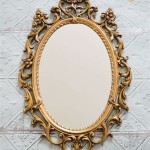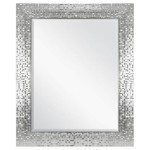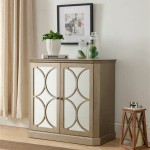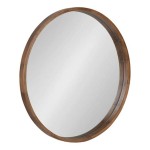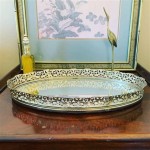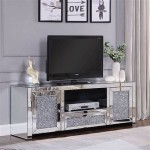Can You Glue a Wood Frame Over a Mirror?
Framing a mirror with wood can significantly enhance its aesthetic appeal, transforming a simple reflective surface into a decorative piece. While traditional framing methods often involve securing the mirror within a frame, gluing a wood frame directly onto the mirror's surface is also a viable option, offering a streamlined and contemporary look. This article explores the feasibility, benefits, drawbacks, and best practices for gluing a wood frame onto a mirror.
Feasibility and Considerations
Gluing a wood frame directly to a mirror is generally feasible. However, several factors must be considered before attempting this method:
*
Type of Mirror:
The mirror's material and backing play a critical role. Thicker, sturdier mirrors are ideal candidates. Thin or poorly backed mirrors may crack under the stress of the glue and frame. *Type of Wood:
Lighter woods are generally preferred to minimize stress on the mirror. The wood should be properly seasoned and prepared to prevent warping or expansion that could damage the mirror. *Type of Glue:
Selecting the appropriate adhesive is crucial. Neutral-cure silicone adhesives or mirror mastic are specifically designed for adhering to glass and are less likely to damage the mirror's reflective backing. *Environmental Factors:
Temperature and humidity fluctuations can impact the bond between the wood and the mirror. Consider the environment where the framed mirror will be placed. *Weight of the Frame:
A heavy frame will put more stress on the mirror and the adhesive bond. Ensure the adhesive can support the combined weight of the frame and the mirror.Advantages of Gluing a Wood Frame to a Mirror
Gluing a frame directly onto a mirror offers several advantages:
*
Sleek Appearance:
This method creates a clean, modern look, minimizing the visual bulk of traditional framing techniques. *Simplified Process:
Gluing is generally a faster and less complex process compared to constructing a traditional frame assembly. *Cost-Effective:
This method can be more economical, requiring fewer materials and potentially less labor.Disadvantages of Gluing a Wood Frame to a Mirror
While advantageous, gluing a wood frame directly to a mirror also presents certain drawbacks:
*
Permanence:
Removing a glued frame can be difficult and may damage the mirror. *Risk of Cracking:
Improper adhesive or excessive weight can crack the mirror. *Limited Repair Options:
Repairing a damaged mirror with a glued frame can be challenging.Best Practices for Gluing a Wood Frame to a Mirror
Adhering to best practices is essential for success when gluing a wood frame to a mirror:
*
Surface Preparation:
Ensure both the mirror and the wood frame are clean and free of dust, grease, or any other contaminants. *Adhesive Application:
Apply adhesive evenly to the back of the wood frame, using a suitable applicator such as a caulking gun. *Clamping and Curing:
Secure the frame to the mirror with clamps or weights, ensuring even pressure distribution. Allow sufficient curing time, as specified by the adhesive manufacturer. *Frame Selection:
Opt for lightweight, stable wood frames that are appropriately sized for the mirror. *Mirror Protection:
Consider using masking tape to protect the mirror's surface during the gluing process.Choosing the Right Adhesive
Selecting the appropriate adhesive is paramount for a successful and lasting bond:
*
Neutral-Cure Silicone:
This type of silicone adhesive offers excellent adhesion to glass and wood, remains flexible, and is resistant to moisture and temperature changes. *Mirror Mastic:
Formulated specifically for mirrors, mirror mastic provides a strong bond and is less likely to damage the mirror's backing. *Construction Adhesive:
While some construction adhesives may be suitable, ensure they are compatible with both glass and wood and are specifically formulated for mirror applications.Preparing the Wood Frame
Proper preparation of the wood frame is crucial for a professional and durable finish:
*
Sanding:
Smooth the frame's surfaces with sandpaper to eliminate imperfections and create a clean finish. *Sealing:
Applying a sealant to the wood protects it from moisture and ensures a consistent adhesive bond. *Finishing:
Applying a finish, such as paint or stain, enhances the frame's appearance and provides further protection. *Measuring and Cutting:
Accurate measurements and precise cuts are necessary for a proper fit.Safety Precautions
Safety should always be a priority when working with adhesives and glass:
*
Ventilation:
Work in a well-ventilated area to avoid inhaling adhesive fumes. *Eye Protection:
Wear safety glasses to protect your eyes from potential splashes or debris. *Gloves:
Use gloves to protect your skin from the adhesive. *Clean Up:
Clean any excess adhesive immediately with a suitable solvent, following the manufacturer's instructions.
How To Build A Diy Frame Hang Over Bathroom Mirror Love Our Real Life

How To Build A Diy Frame Hang Over Bathroom Mirror Love Our Real Life

How To Make A Simple Mirror Frame With Wood Upgrade An Old

How To Glue Wood A Mirror Surface Hunker

How To Make A Simple Mirror Frame With Wood Upgrade An Old

Mirror Frame Diy How To Update A Basic Bathroom Our Faux Farmhouse

Mirror Frame Diy How To Update A Basic Bathroom Our Faux Farmhouse

Diy Rustic Mirror Houseful Of Handmade
Diy Modern Mirror Re Frame What Not To Do Kayla Simone Home

Diy Farmhouse Wood Frame Mirror She Gave It A Go

